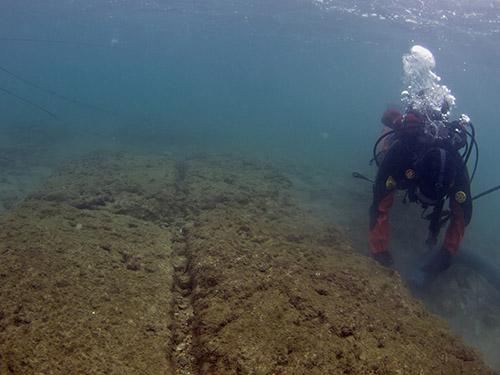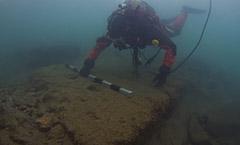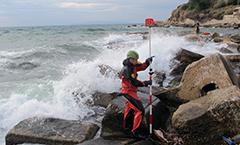Zeaharbourproject
Source - http://www.zeaharbourproject.dk/2012/12/2012-excavations-at-mounichia/

Fig. 1 Archaeologist excavating the monumental side-wall of Shipshed 1 (Vassilis Tsiairis 2012)
December 9, 2012: Excavations resumed for one last campaign in the ancient harbour of Mounichia during the fall of 2012. The modern harbour also acted as the base for running operations elsewhere, which included investigations in Zea as well as the geophysical survey and core drillings. The large generator held in one of the two ZHP containers run the air compressor for filling up scuba tanks, the electric water pumps that powered our water dredges, and the on-site computers used daily for the detailed recording of our dive logs. From there diving archaeologists, surveyors, photographers, and illustrators were deployed daily in order to fulfill all tasks at hand.
Work in Mounichia, modern Mikrolimano, focused on a number of areas both inside and outside the harbour basin. The primary goal was to continue the excavations of the best preserved shipshed located in the northern part of the harbour in area M-G1 (Figs. 1-2).

Fig. 2 Archaeologist placing photo scale on a column base in the colonnade dividing Shipsheds 1 and 2 (Vassilis Tsiairis 2012)
A really deep trench was dug meticulously by the ZHP archaeologists in order to investigate the foundations of the ramp of the shipshed. The aim was to gather information about the construction techniques, and to establish a chronological range for the particular structure based on small finds, such as pot sherds etc. A number of diagnostic ceramic fragments were indeed found deep within the foundation debris in a closed context. These are currently conserved at the conservation laboratory of the Ephorate of Underwater Antiquities and will soon be studied by our ceramics analyst.
In the southwestern part of the harbour, area M-G7, a number of very long test trenches, the longest ca. 18 meters, were excavated on the sides of a lonely but otherwise in situ column base. The aim was to investigate the immediate area for any other structural remains. Unfortunately modern dredging of the harbour seems to have severely affected the particular area, but we left with a clear conscience that we had done our very best to ensure nothing was left behind unrecorded.
Finally the ZHP survey team focused on recording the last remaining parts of tower M-T3 as well as the southern fortified mole. The later is covered almost completely by very large cement blocks of the modern breakwater. Only very small gaps exist between them, some of them wide enough to barely fit our prism holder. Battered by very strong south winds that blew most of our last days on the site, the survey team managed against all odds to gather the much wanted information, thus completing the perfect circle (Fig. 3).

Fig. 3 Digital survey of the modern breakwater covering the submerged ancient fortified mole
11 years of harbour exploration in the Piraeus have come to an end. Campaign after campaign the ZHP managed to built a very strong team of dedicated scientists, educate future students of archaeology, increase public awareness around the world about the glorious naval bases of Athens, and leave behind a very strong archaeological record for generations to follow. We wish to thank all of you that in one way or another have been part of this.
The Zea Harbour Project operates under the auspices of the Danish Institute at Athens and is directed by Dr. Bjørn Lovén. The project is supervised by the Ephorate of Underwater Antiquities. The Carlsberg Foundation has been the project’s principal sponsor since 2004.